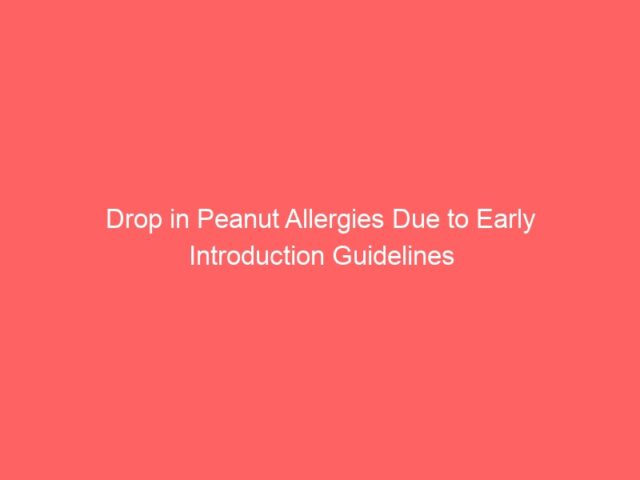Analysis of anaphylactic meals allergy decreased after landmark LEAP examine and professional pointers encouraging early peanut introduction.
RT’s Three Key Takeaways:
- Decline in Meals Allergy Charges – Diagnoses of peanut and different IgE-mediated meals allergic reactions have considerably declined since nationwide pointers started selling early introduction of allergenic meals.
- Influence of Early Introduction – Peanut allergy prevalence dropped from 0.79% to 0.45%, and total IgE-mediated meals allergy charges decreased from 1.46% to 0.93%, indicating that early publicity methods are having measurable public well being advantages.
- Ongoing Prevention Efforts – Consultants emphasize continued schooling and advocacy to develop consciousness of early introduction practices, which may additional cut back childhood meals allergy charges nationwide.
Peanuts characterize some of the frequent causes of immunoglobulin E (IgE)-mediated, or anaphylactic, meals allergic reactions in youngsters, but a landmark examine discovered that early introduction of peanut to infants could decrease their threat of growing this allergy. Now, a brand new examine from researchers from Youngsters’s Hospital of Philadelphia (CHOP) has proven that the charges of prognosis of peanut and different IgE-mediated meals allergic reactions have declined for the reason that adoption of pointers encouraging early introduction practices.
The findings, revealed in the present day within the journal Pediatrics, spotlight how landmark analysis has been translated right into a profitable public well being marketing campaign.
IgE-mediated meals allergic reactions have an effect on about 4% of youngsters, inflicting a toddler’s immune system to react abnormally when uncovered to a number of meals, equivalent to milk, egg, wheat, peanut, or different nuts. Reactions are rapid, inflicting signs that will embrace hives, swelling, problem respiratory and vomiting.
Researchers and clinicians have speculated that IgE-mediated meals allergic reactions will be prevented by early-life publicity of meals antigens within the intestine. A landmark examine supportive of this paradigm was the 2015 Studying Early About Peanut Allergy (LEAP) trial, which demonstrated that early publicity of peanut in 4-11 month previous infants with extreme eczema or egg allergy diminished peanut allergy threat by 81%. Subsequent research have proven that this protecting impact is sustained past early childhood.
The findings of the LEAP trial prompted main pediatric and allergy and immunology organizations to develop consensus pointers to place these findings into apply. Launched in 2015 and 2017, these pointers initially centered on youngsters considered at excessive threat of meals allergy. In 2021, new pointers assist introduction of peanut, egg and different main meals allergens at 4-6 months in all youngsters with no historical past of prior response.
“Everybody has been questioning whether or not these landmark public well being interventions have had an influence on decreasing charges of IgE-mediated meals allergic reactions in the USA,” mentioned the examine’s first creator Stanislaw Gabryszewski, MD, PhD, an attending doctor within the Division of Allergy and Immunology and a core school member within the Scientific Futures Heart of Emphasis at CHOP. “We now have information that counsel that the impact of this landmark public well being intervention is happening.”
Utilizing digital well being report information from the multi-state, major care-based American Academy of Pediatrics Comparative Effectiveness Analysis by Collaborative Digital Reporting (CER2) community, the researchers in contrast charges of meals allergy prognosis at completely different time durations, previous to the institution of early introduction pointers in addition to post-guidelines and post-addendum pointers.
The examine discovered important reductions within the prevalence of peanut IgE-mediated meals allergy (from 0.79% to 0.45% of the examine inhabitants) and any IgE-mediated meals allergy (1.46% to 0.93% of the inhabitants) from the time earlier than the rules to after the addendum pointers had been launched. Peanut transitioned from the topmost to second commonest meals allergen post-guidelines, surpassed by egg. The authors estimate that for about each 200 infants uncovered to meals allergens early in life, one youngster would have been prevented from growing meals allergy.
Whereas the early introduction technique doesn’t fully get rid of peanut and different IgE-mediated meals allergic reactions, the discount in meals allergy prognosis charges is a promising discovering that underscores ongoing public well being efforts to disseminate early introduction practices.
“Our findings have relevance from these of us who deal with sufferers to these caring for infants, and extra consciousness, schooling and advocacy may additional improve the optimistic outcomes we noticed on this examine,” mentioned senior examine creator David Hill, MD, PhD, an attending doctor with the Division of Allergy and Immunology. “Future research may doubtlessly discover particular feeding practices that assist us higher perceive the timing, frequency and dose of meals that optimize safety in opposition to meals allergic reactions.”













